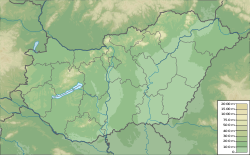Hortobágy National Park
Jász-Nagykun-Szolnok, Hungary | |
|---|---|
| Criteria | Cultural: iv, v |
| Reference | 474 |
| Inscription | 1999 (23rd Session) |
| Area | 74,820 ha |
| Buffer zone | 199,380 ha |
| Website | http://www.hnp.hu/en |
| Coordinates | 47°35′40″N 21°9′24″E / 47.59444°N 21.15667°E |
| Official name | Hortobágy |
| Designated | 11 April 1979 |
| Reference no. | 189[1] |

Hortobágy (Hungarian pronunciation:
Until recently it was believed that this
World Heritage List in 1999 because of its long cultural history (stretching back more than four millennia), its scenery, and its testimony to traditional methods of pastoralism.[5]
One of its most iconic sites is the
dark sky preserve.[6]
Hortobágy has also had more negative connotations, as a site of forced labor under the
communist regime.[7]
Flora and fauna
Hortobágy is a
stone curlew, great bustard and European roller
are represented by breeding populations.
The area is an important stopover site for migrating dotterels, and lesser white-fronted geese.[8]
Hortobágy is also a center for the breeding of Taurus cattle, one of several attempts to re-create the extinct aurochs.[9][10]
Gallery
-
TheNine-holed Bridge
-
Hungarian Grey cattle
See also
References
- ^ "Hortobágy". Ramsar Sites Information Service. Retrieved 25 April 2018.
- ^ "Hortobágy National Park - the Puszta". UNESCO World Heritage Centre. UNESCO. Retrieved 2010-06-21.
- ^ "A Világörökség Bizottság 26. Ülése". Archived from the original on 2007-12-09. Retrieved 2007-12-08.
- ^ "Hortobágy National Park, The Hungarian Puszta" (PDF). Nomination file for inscription of the Hortobágy National Park to the World Heritage List. Ministry for Environment and Regional Policy, Republic of Hungary. 1999. pp. 4–5. Retrieved 30 April 2023.
- ^ "Hortobágy National Park - the Puszta". UNESCO World Heritage Convention. United Nations Educational Scientific and Cultural Organization. Retrieved 30 April 2023.
- ^ "Hortobágy National Park (Hungary)". darksky.org. Archived from the original on 2016-10-12. Retrieved 2016-10-18.
- ^ "Hortobágy Forced Labour Camps 1950-1953 (Excerpt)".
- ^ Lengyel S, Tar J, Rózsa L (2012). "Flock size measures of migrating Lesser White-fronted Geese Anser erythropus" (PDF). Acta Zoologica Academiae Scientiarum Hungaricae. 58: 297–303.
- ^ Margret Bunzel-Drüke: ″Projekt Taurus – En økologisk erstatning for uroksen.″ Archived 2011-10-17 at the Wayback Machine Translated into Danish by Karsten Thomsen. Lohne: ABU 2004; Århus: Nepenthes, 2005. Retrieved 26 November 2013. (in Danish)
- ^ Waltraut Zimmermann, Lydia Kolter, Istvan Sandor: Naturschutzprojekt Hortobágy – Jahresbericht 2003. Archived 2013-12-03 at the Wayback Machine Zeitschrift des Kölner Zoo 2004. Retrieved 26 November 2013. (in German)
External links
- Explore the Hortobágy National Park – the Puszta in the UNESCO Collection on Google Arts and Culture
Further reading
Wikimedia Commons has media related to Hortobágy National Park.
- Gorman, Gerard (1996): The Birds of Hungary. Helm (A&C Black) London, UK. ISBN 0-7136-4235-1.













